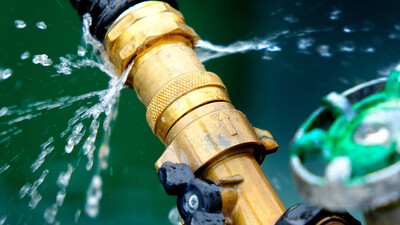How to Detect a Water Leak
You need to be certain you actually have a water leak before you potentially go ripping your property apart to fix it. There are several signs you can look out for to detect whether your home has a leak, such as making sure to look out for flooding, mould, bubbling water flow and pressure.
You can also keep an eye on your water meter, taking readings periodically and ensuring your usage has not increased abnormally. If you notice your meter ticking away even when no water is being used, it’s a clear indication of a leak somewhere in your system.
Common Water Leaks
Dripping Taps
Symptoms:
A dripping tap is usually easy to spot. You'll notice a persistent drip from the tap spout even when the tap is turned off. This can result in annoying noises and increased water bills over time.
Causes:
Dripping taps are often caused by worn-out or damaged washers, O-rings, or valve seats within the tap mechanism. Over time, these components can degrade or accumulate debris, leading to leaks.
How to Fix it:
To fix a dripping tap, it is important to first turn off the water supply to avoid any unwanted spillage. Then, open up the tap and inspect the washer. The cause may be a build-up of debris that you can clean away, or the washer may be damaged and you will need to replace it. Only change the washer if you feel comfortable doing so; if not, call a professional.
Leaky Radiators
Symptoms:
Leaky radiators can be identified by puddles of water around the base, damp patches on the walls or floors, and reduced heating efficiency.
Causes:
Leaking radiators are incredibly common, but can cause a lot of damage to floors, ceilings, and wiring. Leaking valves or valve spindles could be the cause of a leaking radiator, or the culprit could also be corrosion of the pipe coupling.
How to Fix it:
Often, draining the radiator system and refilling it can fix the majority of radiator leaks. If this doesn’t resolve the issue, it is recommended you call a plumber to fix it as the problem is likely deeper in the pipe system and requires professional intervention.
Leaking Water Pipe Joints
Symptoms:
You might notice water pooling around the joints, damp patches on walls or ceilings, or even a decrease in water pressure.
Causes:
Leaks from plastic pipes and joints, such as those underneath the kitchen sink, can occur due to poor installation, wear and tear, or degradation of sealing compounds over time.
How to Fix it:
Leaks from plastic pipes and joints can usually be fixed without the need for a professional. Often, all it takes is drying the area and sealing the leak once you have found it. This involves removing and replacing the affected section of pipe, or a temporary fix can be made using rubber or silicone repair tape or repair epoxy.
Toilet Leaking
Symptoms:
Signs of a leaking toilet include water pooling around the base, the sound of water trickling into the bowl when not in use, or a constantly running toilet.
Causes:
Leaking toilets are considered unsanitary, but it doesn’t always spell disaster. If the leaks come from the bottom of the toilet and only really happen after flushing, it could be an issue with the rubber seal on the toilet base or the tee bolts that hold your toilet in place.
How to Fix it:
If this happens, you should stop using the toilet and disinfect around the leak as it will be wastewater from the toilet bowl that is contaminated. To fix the leak, you will want a wrench to unscrew and tighten the bolts. Ensure the rubber seal is properly seated and in good condition. If it’s damaged, replace it with a new one.
Bath or Shower Leaking
Symptoms:
Common signs include water stains on ceilings below the bathroom, damp floors, mould growth, or water pooling around the bath or shower.
Causes:
If your bath or shower is leaking, the first thing to check is the plughole seal – if this is broken it can cause overflowing or leaks.
You could also check the supply pipes to make sure the leak is more internal. These pipes may be hidden behind a wall, so you may need to remove panels of the bath or shower enclosure or even remove elements of the walls. This kind of leak can cause a lot of damage, so it’s important to detect it and take steps to fix it sooner rather than later.
The final leaking issue around baths can be when the silicone seal around the tub degrades over time, which can allow moisture to seep through. This is a quick fix, so long as you seal the bath regularly to prevent this damage in advance.
How to Fix it:
- For a broken plughole seal, apply a new waterproof sealant around the drain and let it dry completely before using the bath or shower.
- If you suspect a leak from the supply pipes, turn off the water supply and inspect the pipes by removing the necessary panels. Replace any damaged pipes or fittings.
- For degraded silicone seals, carefully remove the old sealant, clean the area and apply a new bead of silicone sealant. Ensure it’s evenly applied and let it cure before using the bath or shower.
By following these steps, you can often fix water leaks yourself and prevent further damage to your home. However, if you ever feel out of your depth or the leak persists, don't hesitate to call a professional plumber.

Written by
Bob Stone
Technical Sales
Heading up our Technical Estimating Department, Bob is our in-house quantity surveyor.

